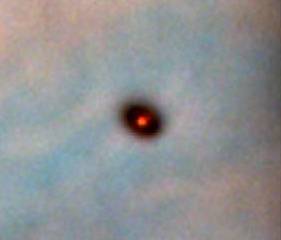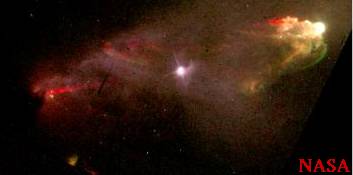|
B. Protostars.
 As gravity As gravity continues to compress these clumps, they tend toward a spherical shape.
Their temperature rises rapidly and the clumps begin to glow from the heat
released by the compression of the gases and dust. When they begin to give
off visible light, these clumps are now protostars. From the outside
these protostars may not be visible because they are still surrounded by
an envelope of cooler gases. As the contraction continues, and the temperatures
continue to rise, the contraction slows down somewhat because of the internal
rise in pressure.
continues to compress these clumps, they tend toward a spherical shape.
Their temperature rises rapidly and the clumps begin to glow from the heat
released by the compression of the gases and dust. When they begin to give
off visible light, these clumps are now protostars. From the outside
these protostars may not be visible because they are still surrounded by
an envelope of cooler gases. As the contraction continues, and the temperatures
continue to rise, the contraction slows down somewhat because of the internal
rise in pressure.
T Tauri
The rise in temperature is greatest in the center of these protostars.
Eventually, when the temperature exceeds 1 million K (degrees Kelvin) in
the center of these protostars, Hydrogen nuclei begin to combine and fuse
into Helium nuclei. During fusion, a very small amount of mass converted
to energy in the form of EM radiation. When the energy is produced from
fusion rather than from contraction, a new star is born. Because fusion
begins in the core of this new star, its outside is still surrounded by
gas and dust and is still opaque.
 But fusion pressure
rapidly pushes this originally dark envelope outward, leaving behind a
bright shiny new star that emerges from this dark opaque cocoon. Depending
on its mass, rotation and a host of other factors, the original clump that
we are following in this story will give rise to either a single star system,
a multiple star system, or a planetary system. But fusion pressure
rapidly pushes this originally dark envelope outward, leaving behind a
bright shiny new star that emerges from this dark opaque cocoon. Depending
on its mass, rotation and a host of other factors, the original clump that
we are following in this story will give rise to either a single star system,
a multiple star system, or a planetary system.
Usually, the whole clump we mentioned in the nebular stage will form
hundreds of stars and more than one clump will be forming stars at the
same time in the same region of a nebula. Thus, new stars will be born
in open star clusters, whose individual stars will disperse across the
galaxy over time as their orbits are affected by the gravitational forces
of the galaxy.
In this early stage of a star's formation, the outward fusion pressure
which tends to blow the star up, and the inward pull of gravity which tends
to collapse the star, are not balanced yet. This young star is still unstable,
occasionally ejecting matter in bursts and varying its light output. But
as time goes by, eventually equilibrium between gravity and fusion pressure
is reached, and the star enters the stable period of its life, the main
sequence stage. |





